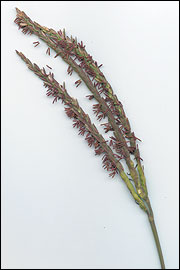Eastern gamagrass (Tripsacum dactyloides (L.) L.)
Warm-season grasses
Eastern gamagrass, the king of bunchgrasses, is used for pasture, hay and silage. It grows well in wetter areas but prefers deep, well-drained soils. Eastern gamagrass lends itself to pasture-based operations because it has a more even distribution of yield over the grazing season than do many other warm-season grasses. It also has better forage quality than many other warm-season grasses. Despite these advantages, eastern gamagrass has a few problems. Seed production is difficult, and gamagrass is slow to establish. Furthermore, it is easily overgrazed. Eastern gamagrass grows well throughout Missouri but is most popular in the central and western regions of the state. Despite its limitations, eastern gamagrass can be an important part of a forage system.
 Eastern gamagrass
Eastern gamagrass
 Yield distribution of eastern gamagrass in Missouri.
Yield distribution of eastern gamagrass in Missouri.
- Origin: Eastern North America
- Adaptation to Missouri: Statewide
- Growth habit: Rhizomatous, perennial bunchgrass.
- Blade: Flat, glabrous or sometimes pubescent on upper surface near ligule, scabrous margins, prominent midrib.
- Sheath: Round, smooth, split, glabrous, sometimes pubescent near top.
- Ligule: A short ring of hairs, truncate.
- Auricles: Absent.
- Seed head: Panicle, composed of 1 to 4 raceme-like branches.
- Fertilization: 50 lb N/acre in spring when grass is 3 to 5 inches tall. Apply 50 lb N/acre every six weeks thereafter. Phosphorus and potassium to soil test.
- Burning management: Every year or two, in early spring before new growth is 1 inch long.
- Timing of production: 85 percent of growth between May 15 and Aug. 31.
- When to begin grazing: When grass is 14 inches tall.
- When to cut for hay: Very early boot stage.
- Lowest cutting or grazing height: 8 inches
- Fall management: Do not hay or graze after Sept. 15.

